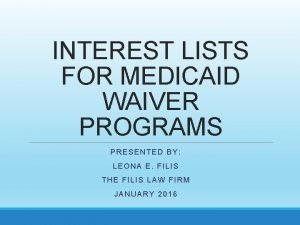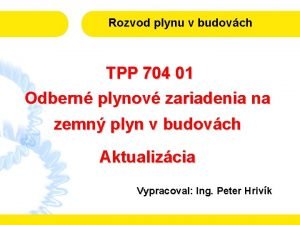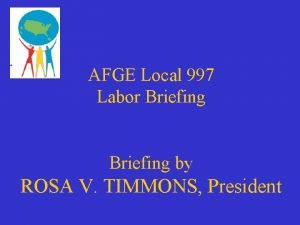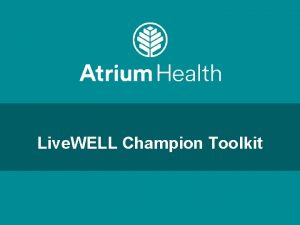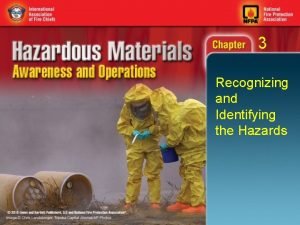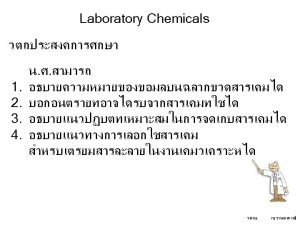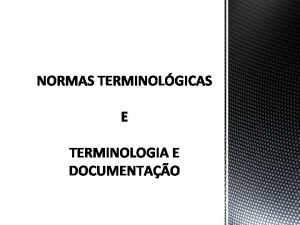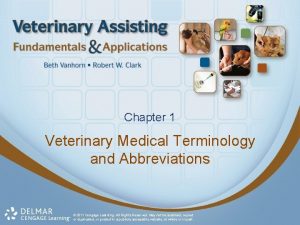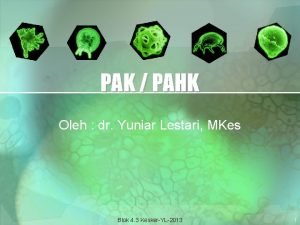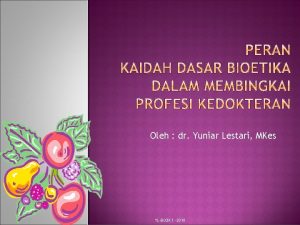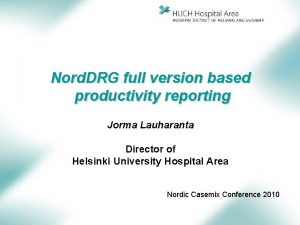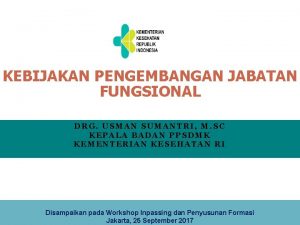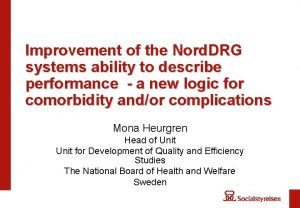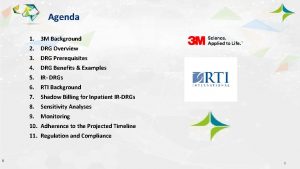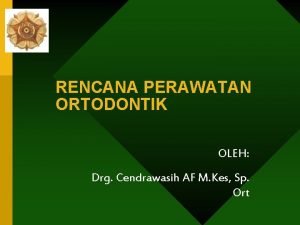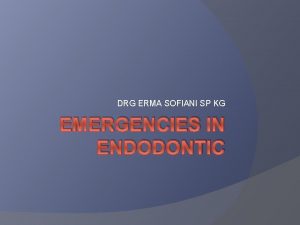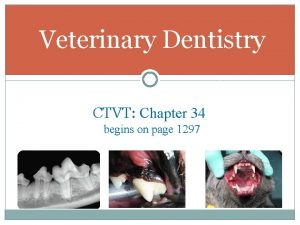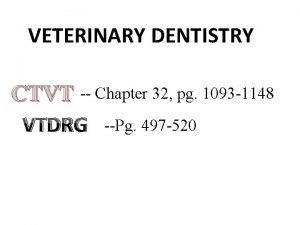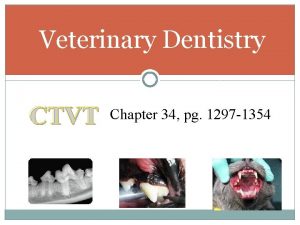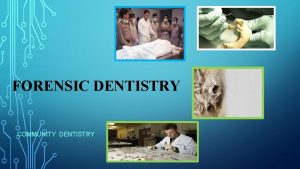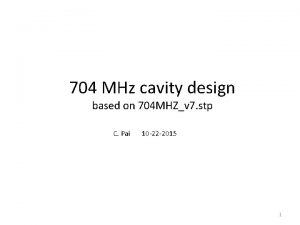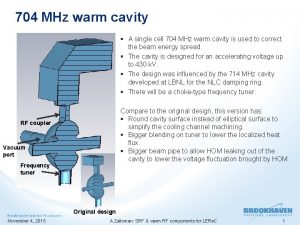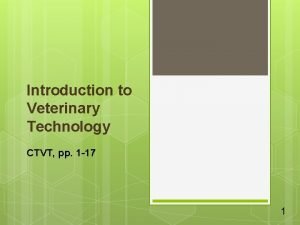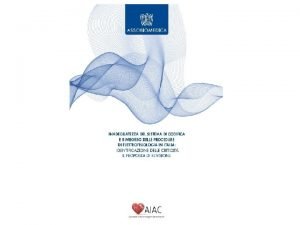Veterinary Dentistry CTVT Chapter 36 DRG 692 704



















- Slides: 19

Veterinary Dentistry CTVT: Chapter 36 DRG: 692 -704

Student Objectives CTVT pgs 1217 -1229 �Recognize a patient’s overall dental health status �Perform routine dental prophylaxis safely and efficiently Recognize, describe, and use common dental instruments �Understand client education regarding home care �Prepare to be the dental technician senior term �Prepare for VTNE

Veterinary Dentistry �American Veterinary Dental College Organization recognized by the American Board of Veterinary Specialties of the AVMA �Board Certified Veterinary Dentists �GCVS and TAMU

Vet Tech Dental Organizations �NAVTA is responsible for governing and overseeing Veterinary Technician Specialists (VTS). Examples: Dentistry, anesthesia, emergency and critical care, internal medicine, behavior, zoo, etc. Opportunities for advanced training in dentistry: � Academy of Veterinary Dental Technicians (AVDT) credentials LVTs as specialists in dentistry Requires 3000 hours experience then…secure a mentor, maintain case logs, write case reports, pass a specialty exam, and attend extra CE courses. See www. avdt. us for further info.

Legal Aspects � The American Veterinary Dental College (AVDC) considers it appropriate for the veterinarian to delegate maintenance dental care and various dental tasks to LVTs. � Texas Administrative Code: Chapter 573 (d) In dogs and cats, a licensed veterinary technician under direct or immediate supervision of a veterinarian may extract loose teeth or dental fragments with minimal periodontal attachments by hand without the use of an elevator.

Dental Tasks for Veterinary Technicians �Oral examination and charting �Professional dental cleaning Prevention and treatment �Taking and developing dental radiographs �Taking impressions and making models �Performing nonsurgical, subgingival root planning �Client education Home care and prevention

Client Education is Important! �Dental disease can lead to: �This can be prevented! Home care Annual exam Annual professional dental prophylaxis

Why is it exciting? !

History and Extraoral Examination �Dental procedures require ___________ �Before animal is anesthetized: 1. Obtain a proper history 2. Ask about general medical info, medications, nutrition, treats, toys, etc. 3. Perform an extraoral exam on the pet Palpate muscles of the face Look for ____ and _____ discharge Palpate mandibular salivary glands Palpate ________ lymph nodes

Intraoral Examination (Awake) �The entire mouth should be evaluated, however we do only a quick exam while awake: Access patient’s _____ Check for persistent ______ teeth or missing teeth Evaluate overall appearance of __________ Estimate stage of periodontal disease Goals: 1. 2. 3.

Intraoral Examination- Anesthetized �Once anesthetized, a more thorough exam can be done: 1. Soft tissue Pharynx- evaluate for inflammation/neoplasia/lesions Tongue- check for lesions Mucosa- should be pink or pigmented; no lesions seen

CUPS �Ulcerations of the ____ adjacent to diseased teeth Caused by the bacteria in plaque Very painful!

Know What’s Normal! �Hard palate- covered in ____ Examine closely in ________ breeds �________ - bump that is midline, caudal to maxillary incisors �_____ salivary ducts on quadrants 1 &2 Appear as bumps dorsal to maxillary 4 th PM and 1 st M

Intraoral Examination- Anesthetized 2. Teeth Number, fractures, mobility, etc 3. Periodontium Inflammation, periodontal pockets, bone loss, etc. *Radiographs are often necessary to access the complete oral health status


The Periodontum The periodontum composes the structures that attach the tooth to the jaw and provide support & resistance to normal, functional forces.

The Periodontum 1. Gingiva = gum tissue surrounding teeth Healthy gingiva can be pink or pigmented The margin lies closely against the crown of the tooth The gingival _____ is the shallow groove between the tooth and the gingiva. Normal depth is _______ in canines; up to ______ in felines Called a ______ when deeper.

The Periodontium 2. Cementum is a bone-like tissue that covers the root surface. It is stronger than bone but not as strong as enamel. It is capable of repairing itself. 3. Periodontal _____ attaches cementum to the alveolar bone.

The Periodontium 4. Alveolar bone forms the tooth socket. Blood vessels and nerves run through the alveolar bone Furcation area-
 713-692-1635
713-692-1635 Tpp 704 01 download
Tpp 704 01 download Afi 36 704
Afi 36 704 704-631-1500
704-631-1500 Im-102 intermodal tank
Im-102 intermodal tank Target allocation partnership
Target allocation partnership Nfpa 704 คือ
Nfpa 704 คือ Iso 704
Iso 704 704 kar 3:305
704 kar 3:305 704 error
704 error Gib medical abbreviation
Gib medical abbreviation Drg dwi imbang lestari
Drg dwi imbang lestari Drg dwi imbang lestari
Drg dwi imbang lestari Nord drg
Nord drg Usman sumantri
Usman sumantri Nord drg
Nord drg Calcul drg
Calcul drg Irdrg
Irdrg Ekspansi sagital dan transversal
Ekspansi sagital dan transversal Penatalaksanaan pulpitis reversibel
Penatalaksanaan pulpitis reversibel
